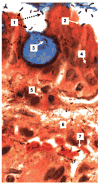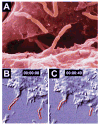Helicobacter pylori is invasive and it may be a facultative intracellular organism
- PMID: 17388791
- PMCID: PMC1913845
- DOI: 10.1111/j.1462-5822.2007.00921.x
Helicobacter pylori is invasive and it may be a facultative intracellular organism
Abstract
The pathogenicity of many bacteria colonizing the gastrointestinal tract often depends on their ability to gain access to cells that are normally non-phagocytic. Helicobacter pylori colonizes the stomach of over half the world population and is the main cause of peptic ulcer disease and gastric cancer. It is generally considered to be a non-invasive pathogen present only in the lumen of the stomach and attached to gastric epithelial cells although a number of in vivo and in vitro studies have demonstrated that H. pylori is in fact invasive. In addition, H. pylori can repopulate the extracellular environment after complete elimination of extracellular bacteria with gentamicin, suggesting it may be considered a facultative intracellular bacterium. This review examines the validity of these observations and describes the evidence suggesting that the intracellular presence of H. pylori plays a role in the induction of diseases, in immune evasion, and in life-long persistence of the bacterium in the stomach of a majority of humans.
Figures




References
-
- Amieva MR, Salama N, Tompkins LS, Falkow S. Helicobacter pylori enter and survive within multivesicular vacuoles of epithelial cells. Cell Microbiol. 2002;4:677–690. - PubMed
-
- Andersen LP, Holck S. Possible evidence of invasiveness of Helicobacter (Campylobacter) pylori. Eur J Clin Microbiol Infect Dis. 1990;9:135–138. - PubMed
-
- Andersen LP, Blom J, Nielsen H. Survival and ultrastructural changes of Helicobacter pylori after phagocytosis by human polymorphonuclear leukocytes and monocytes. APMIS. 1993;101:61–72. - PubMed
-
- Anonymous. Helicobacter pylori in peptic ulcer disease. NIH Consensus Conference. JAMA. 1994a;272:65–69. - PubMed
Publication types
MeSH terms
Grants and funding
LinkOut - more resources
Full Text Sources
Other Literature Sources
Medical

